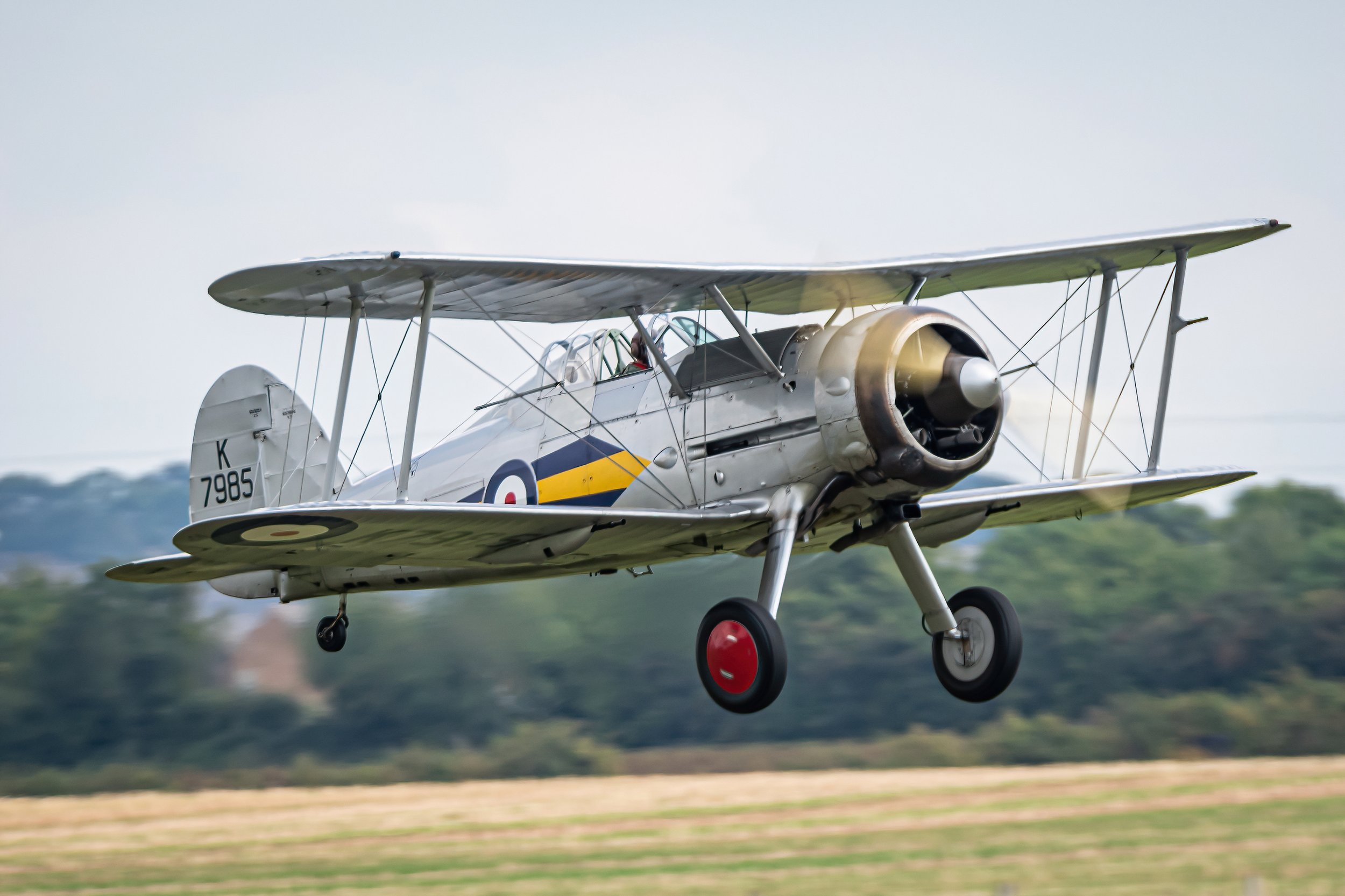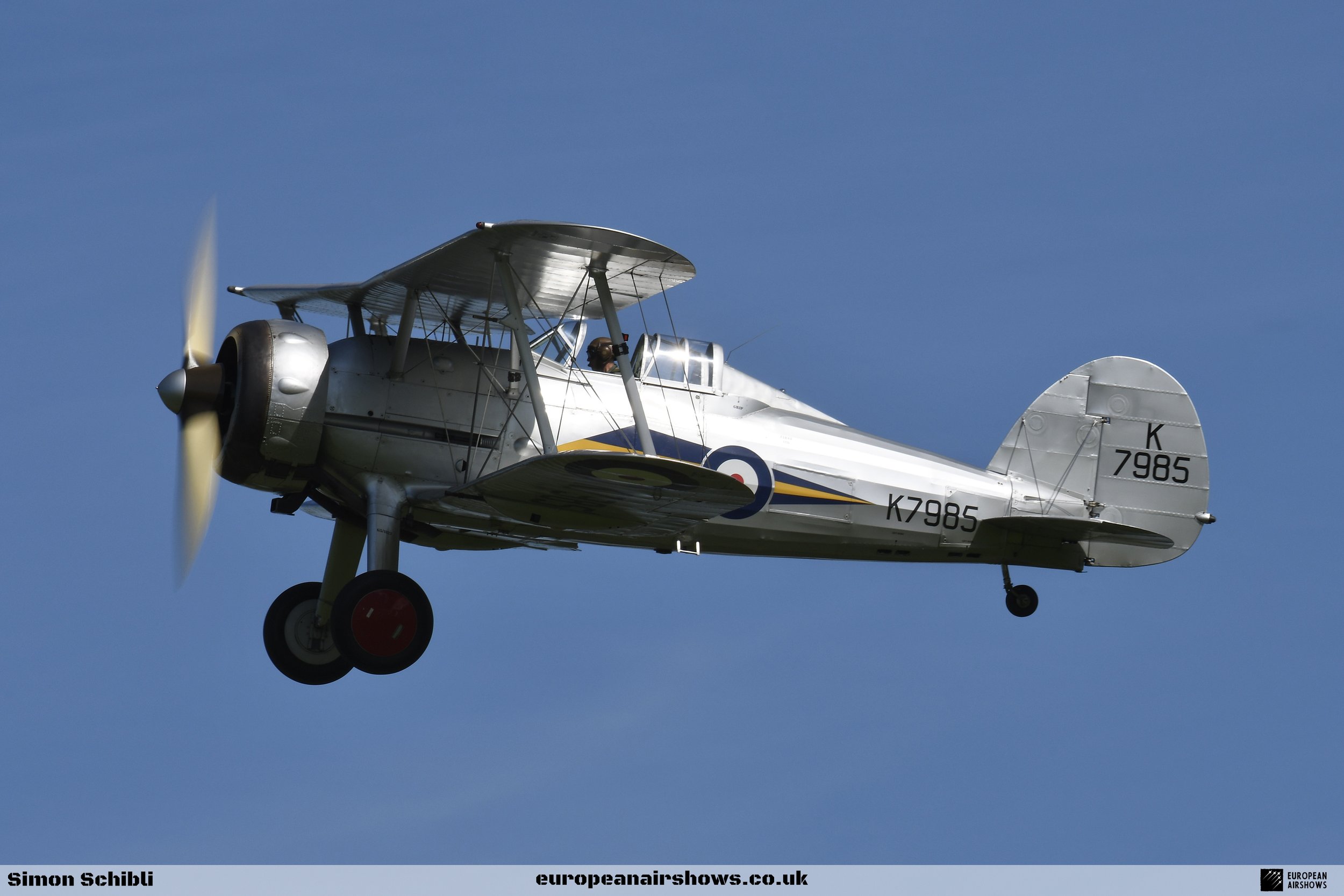
September 12 / Gloster Gladiator first flight
First Flight 12 September 1934
Gloster Gladiator
The Gloster Gladiator is a fascinating aircraft that occupies a unique position in the annals of aviation history. As one of the last biplane fighters to see significant service, the Gladiator represents the transition from the biplane era of the 1920s and 1930s to the monoplane fighters that dominated the skies during World War II. Its story is interwoven with the development of military aviation in Britain and reflects the changing dynamics of aerial warfare.
The Gladiator’s origins can be traced back to the late 1920s when the British Royal Air Force (RAF) began seeking a new fighter aircraft to replace its ageing biplane fleet. The RAF recognized the need for a more advanced fighter that could maintain air superiority in the face of evolving threats. In response to this demand, Gloster Aircraft Company, a prominent British manufacturer, began work on a new design that would eventually become the Gladiator.
The design of the Gladiator was heavily influenced by the experiences of World War I and the subsequent developments in aviation technology. The aircraft was a biplane, featuring a distinctive configuration with two wings stacked one above the other. This design provided excellent manoeuvrability and stability, which were critical attributes for a fighter aircraft during dogfights. The Gladiator was powered by the Bristol Mercury radial engine, which offered a good balance of power and performance, enabling the aircraft to reach speeds of around 250 miles per hour.
The first prototype of the Gladiator made its maiden flight on September 12, 1934. Initial testing revealed that the aircraft had impressive handling characteristics and agility, making it a formidable opponent in aerial combat. The Gladiator was equipped with eight.303 Browning machine guns, four of which were mounted in the wings and four in the fuselage. This armament configuration allowed for a significant volume of fire, enhancing the aircraft’s lethality against enemy targets.
In 1937, the Gladiator entered service with the RAF, and it quickly became the standard fighter for several squadrons. Its deployment coincided with a period of escalating tensions in Europe, as the threat of conflict loomed on the horizon. The Gladiator was not only adopted by the RAF but also found favour with several other air forces, including those of Sweden, Finland, and Norway. Its reputation as a reliable and effective fighter contributed to its popularity among various nations.
The Gladiator’s most notable operational history occurred during the early stages of World War II. As the conflict erupted in 1939, the RAF deployed Gladiators to various theatres, including the Battle of Britain and the North African Campaign. One of the most famous engagements involving the Gladiator took place in Finland during the Winter War against the Soviet Union from 1939 to 1940. The Finnish Air Force, equipped with Gladiators, achieved notable successes against Soviet aircraft, showcasing the biplane’s agility and effectiveness in combat.
In North Africa, Gladiators were utilized by British and Commonwealth forces in the fight against Italian and German forces. The aircraft’s performance in the harsh desert environment was commendable, and it proved to be a valuable asset for the RAF in providing air support to ground troops. The Gladiator’s ability to operate from rough airfields and its rugged design made it well-suited for the challenging conditions of the North African theatre.
Despite its successes, the Gladiator faced increasing competition from more advanced monoplane fighters such as the Supermarine Spitfire and the Hawker Hurricane. As the war progressed, the biplane’s limitations became more apparent, particularly in terms of speed and firepower. By the time the United States entered the war in 1941, the Gladiator was increasingly relegated to secondary roles, such as training and reconnaissance, as newer aircraft took over the frontline duties.
The Gladiator’s service life was not limited to the RAF. It was also operated by several other nations throughout the war. The Swedish Air Force, for example, utilized the Gladiator as a primary fighter until it was eventually replaced by more modern aircraft. In addition to Sweden and Finland, the Gladiator saw service with the Royal Canadian Air Force and the Royal New Zealand Air Force, among others.
The last operational Gladiators were retired from service in the early 1950s, marking the end of an era for biplane fighters. However, the aircraft’s legacy lives on in aviation history. The Gladiator’s design and performance influenced the development of subsequent fighter aircraft, and its role in early World War II combat has been the subject of numerous books and documentaries.
Today, the Gloster Gladiator is celebrated as a symbol of a bygone era in aviation. Its distinctive silhouette and historical significance have made it a favourite among aviation enthusiasts and historians alike. Several examples of the Gladiator have been preserved in museums and private collections, serving as a reminder of the aircraft’s contributions to military aviation.
In conclusion, the Gloster Gladiator is more than just an aircraft; it is a representation of a pivotal moment in the history of aviation. Its development marked the transition from biplane fighters to the more advanced monoplane designs that would dominate the skies during World War II. The Gladiator’s operational history, characterized by its service in various theatres and its adaptability to different roles, underscores its importance in the evolution of military aviation. As a symbol of resilience and innovation, the Gladiator remains a cherished part of aviation heritage, reminding us of the bravery and skill of the pilots who flew it during a tumultuous period in history.
Gloster Gladiator Facts
Last Biplane Fighter in Service: The Gladiator was the last biplane fighter to serve in the Royal Air Force (RAF). It was designed in the 1930s but continued to be used in various roles even as monoplane fighters became the standard.
First Flight: The Gladiator first flew in 1928, but it did not enter service until 1937. Its design was influenced by the need for a fighter that could compete with contemporary monoplane designs.
Export Success: The Gladiator was not only used by the RAF but was also exported to several other countries, including Sweden, Finland, and Norway. The Finnish Air Force, in particular, used the Gladiator effectively during the Winter War against the Soviet Union.
Combat in Multiple Theaters: The Gladiator saw combat in various theatres during World War II, including North Africa, the Mediterranean, and the Far East. It was used by British, Commonwealth, and even Axis forces in some instances.
Versatile Roles: While primarily designed as a fighter, the Gladiator was also used in ground attack and reconnaissance roles. Its ability to carry bombs and other ordnance made it a versatile platform.
Notable Achievements: Gladiators scored several notable victories during the early stages of World War II. For example, during the Siege of Malta, Gladiators from Malta played a crucial role in defending the island against Italian and German air attacks.
Tragic Losses: The Gladiator was involved in several tragic incidents, including the loss of aircraft and pilots during combat. One notable incident was the “Gladiator Incident” in 1940, where a squadron of Gladiators was lost in a surprise attack.
Unique Design Features: The Gladiator featured a distinctive design with a circular fuselage and a fabric-covered structure. Its biplane configuration provided excellent manoeuvrability, although it was increasingly outclassed by newer monoplane fighters.
Surviving Examples: A small number of Gladiators have been preserved and are displayed in museums or flown at airshows. These surviving examples serve as a testament to the aircraft’s historical significance.
Cultural Impact: The Gladiator has made appearances in various films and documentaries, often symbolizing the bravery of the RAF during the early years of World War II. Its iconic design and historical role have made it a beloved aircraft among aviation enthusiasts.











